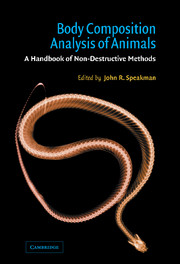Book contents
- Frontmatter
- Contents
- List of contributors
- Preface
- Acknowledgements
- Introduction
- 1 Morphological indicators of body condition: useful or wishful thinking?
- 2 Standard methods for destructive body composition analysis
- 3 The isotope dilution method for the evaluation of body composition
- 4 Gas dilution methods: elimination and absorption of lipid-soluble gases
- 5 The use of total body electrical conductivity (TOBEC) to determine body composition in vertebrates
- 6 The use of bioelectrical impedance analysis (BIA) for estimation of body composition
- 7 The assessment of body composition and other parameters by ultrasound scanning
- 8 The use of dual-energy X-ray absorptiometry for the measurement of body composition
- Index
5 - The use of total body electrical conductivity (TOBEC) to determine body composition in vertebrates
Published online by Cambridge University Press: 19 January 2010
- Frontmatter
- Contents
- List of contributors
- Preface
- Acknowledgements
- Introduction
- 1 Morphological indicators of body condition: useful or wishful thinking?
- 2 Standard methods for destructive body composition analysis
- 3 The isotope dilution method for the evaluation of body composition
- 4 Gas dilution methods: elimination and absorption of lipid-soluble gases
- 5 The use of total body electrical conductivity (TOBEC) to determine body composition in vertebrates
- 6 The use of bioelectrical impedance analysis (BIA) for estimation of body composition
- 7 The assessment of body composition and other parameters by ultrasound scanning
- 8 The use of dual-energy X-ray absorptiometry for the measurement of body composition
- Index
Summary
Introduction
The use of electrical conductivity of a subject as an indirect method of assessing body composition has been made for many years, particularly in the field of biomedicine (for reviews see Van Loan, 1990; Kushner, 1992; Yanovski et al., 1996). The technique employed primarily by biomedics is known as bioelectrical impedance analysis (BIA: Chapter 6), in which the electrical conductivity of the subject is measured between discrete points on the subject's surface.
BIA differs from total body electrical conductivity (TOBEC®) measurement, because, in the latter, the whole subject is placed within a chamber surrounded by a conductive coil, producing a measure of total body conductivity. The acronym TOBEC has been registered as a trademark of the main manufacturer (EM-SCAN). In theory, greater standardization can be achieved using TOBEC® than with BIA as the need to attach electrodes to the skin surface, which might cause problems in most non-human animals, is removed. The TOBEC® method of determining body composition does not cause discomfort to the subject, is relatively rapid and requires little special training to use (Fiorotto et al., 1987). It has been used on a wide range of animals including fish (Bai et al., 1994; Gillooly & Baylis, 1999), reptiles (Angilletta, 1999), birds, e.g. Scott et al. (1994, 1995) including birds' eggs (Williams et al., 1997) and mammals, e.g. Gosselin & Cabanac (1996), Raffel et al. (1996) including humans, e.g. Presta et. al. (1983), Van Loan et al. (1987), Kretsch et al. (1997).
- Type
- Chapter
- Information
- Body Composition Analysis of AnimalsA Handbook of Non-Destructive Methods, pp. 127 - 160Publisher: Cambridge University PressPrint publication year: 2001
- 11
- Cited by



